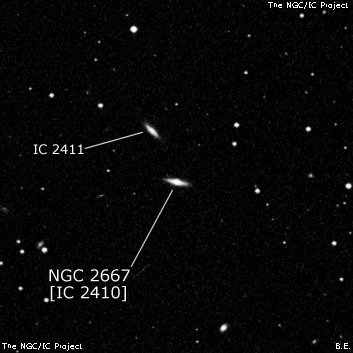
Heinrich d'Arrest discovered NGC 2667 on 18 Feb 1862 while observing and measuring NGC 2672. His single position is not very accurate, but 7 seconds of time east is CGCG 090-016, the brighter of pair of galaxies. Max Wolf found NGC 2667, as well as the companion 1.6' NNE on Heidelberg plates and catalogued both galaxies (IC 2410 and 2411) without reference to NGC 2667. So, NGC 2667 =(IC 2410 and NGC 2667B = IC 2411. CGCG (090-016) and MCG (+03-23-007) both label this galaxy as(IC 2410, without reference to NGC 2667.
Interestingly, Ralph Copeland, observing NGC 2667 with the 72" on 26 Dec 1873 noted "cF, pS, lE p f, was thought to have an eF companion about 2' nf." The companion is clearly IC 2411. Dreyer later reobserved the field in 1876 and apparently was not convinced: "eF; I think it is only a *16 m +/- nf." Due to Dreyer's uncertainty, IC 2411 missed receiving a NGC designation.
400/500mm - 17.5" (1/28/89): very faint, small, elongated E-W.
600/800mm - 24" (2/16/15): at 322x; fairly faint, fairly small, elongated 5:2 E-W, 35"x14", low even surface brightness. Forms a pair with IC 2411 1.6' NNE. This close companion (similar redshift) appeared very faint, fairly small, elongated 2:1 SW-NE, 25"x12", very low surface brightness. In a group with NGC 2762/2763 13' ENE and IC 2399 11' SW.
Notes by Steve Gottlieb